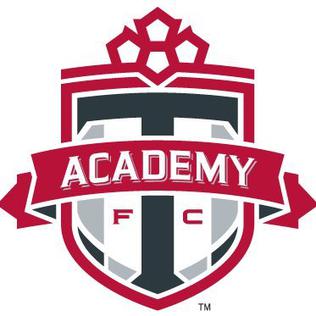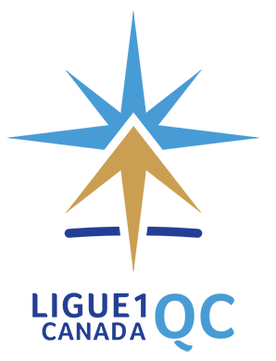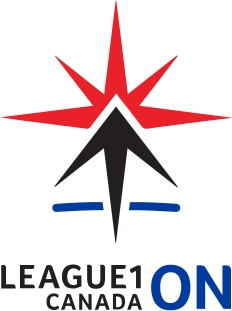Related Research Articles
The Open Canada Cup was an annual knock-out cup competition in Canadian Soccer. The competition was first held during the 1998 season as the CPSL League Cup. It was organized by the Canadian Soccer League originally as a League Cup for CSL member clubs. After operating the competition for several seasons as an exclusive tournament, the league's ownership decided in 2003 to grant accessibility to all Canadian professional and amateur clubs. The decision was influenced by the lack of initiative by the Canadian Soccer Association in providing a potential candidate for the CONCACAF Champions' Cup.

In Canada, soccer is the most popular sport in terms of participation rate; according to FIFA's Big Count, almost 2.7 million people played in Canada in 2006. Professional soccer in Canada is played in the Canadian Premier League and Major League Soccer. Canada also has many semi-professional and amateur soccer leagues. Canada's men's and women's national soccer teams are ranked 33rd and 6th respectively in the FIFA World Rankings as of February 10, 2022.

The Canadian Soccer Association is the governing body for soccer in Canada. Headquartered in Ottawa, Ontario, the federation is a full member of FIFA and governs Canadian soccer at the international, professional, and amateur levels, including: the men's and women's national teams, Canadian Premier League, youth organizations, beach soccer, futsal, Paralympic and deaf national teams. The Canadian Soccer Association also administers and operates the Canadian Championship.

The second iteration of the Toronto Blizzard was a Canadian professional soccer team in Toronto, Ontario that competed in the Canadian Soccer League, National Soccer League, and the American Professional Soccer League. The club was formed shortly after the folding of the original team that coincided with the folding of the North American Soccer League. This edition of the club folded in 1993 after poor financial prospects and lack of attendance.

The Canadian Championship is an annual soccer tournament contested by Canadian professional teams. The winner is awarded the Voyageurs Cup and a berth in the CONCACAF Champions Cup. It is contested by Major League Soccer sides Toronto FC, Vancouver Whitecaps FC, and CF Montréal, eight Canadian Premier League sides, and the champions of League1 Ontario, League1 British Columbia, and Ligue1 Québec. The tournament is organized by the Canadian Soccer Association and has been broadcast on OneSoccer since 2019.

Toronto FC Academy, also known as TFC Academy, is the youth academy and development system of Canadian Major League Soccer club Toronto FC.

The Canadian Soccer League was a Division 1 professional soccer league that operated for six seasons between 1987 and 1992. It was a nationwide league that had teams in six provinces over the course of its history. It was the last top-division league in Canada until the Canadian Premier League began play in 2019.

The Canadian Soccer League is a semi-professional league for Canadian soccer clubs primarily located in the province of Ontario, and claims the history of the Canadian National Soccer League (CNSL). It is a non-FIFA league previously sanctioned by the Canadian Soccer Association (CSA), but now affiliated with the Soccer Federation of Canada (SFC). As of 2023, it consists of seven teams, all located in Ontario. The season usually runs from May to October, with most games played on the weekend followed by a playoff format to determine the overall champion.

The American Professional Soccer League (APSL) was a professional men's soccer league with teams from the United States and later Canada. It was formed in 1990 by the merger of the third American Soccer League with the Western Soccer League. It was the first outdoor soccer league to feature teams from throughout the United States since the demise of the North American Soccer League in 1984.

Ligue1 Québec (L1QC) is a semi-professional men's and women's soccer league in Quebec, Canada. Founded in 2011 as the Première ligue de soccer du Québec, the league is sanctioned by the Canadian Soccer Association and the Quebec Soccer Federation.

League1 Ontario (L1ON) is a semi-professional men's soccer league in Ontario, Canada. The league is sanctioned by the Canadian Soccer Association and the Ontario Soccer Association.
The 2014 Canadian Soccer League season was the 17th since its establishment where a total of 20 teams from Ontario took part in the league. The season began on May 24, 2014, and concluded on October 26, 2014. York Region Shooters won their second championship in a 5–4 victory in a penalty shootout over Toronto Croatia in the CSL Championship final held at Esther Shiner Stadium in Toronto. York Region became the second club in the league's history to produce a perfect season, and championship after the Toronto Olympians in the 1999 season.

Molham "Mo" Babouli is a professional footballer who plays for York United of the Canadian Premier League. Born in the United Arab Emirates, he represented Canada at youth level and currently represents the Syria national team.

Vincent Ursini is a Canadian accountant, former soccer executive, and stage actor.

League1 Ontario is a semi-professional women's soccer league in Ontario, Canada. The league is sanctioned by the Canadian Soccer Association and the Ontario Soccer Association as a pro-am league in the Canadian soccer league system. League1 Ontario part of League1 Canada, the national third tier with regional divisions, with L1O equivalents in Alberta, British Columbia, and Quebec.

League1 Canada is a national pro–am soccer organization in Canada. It consists of four regional leagues; League1 Alberta, League1 British Columbia, League1 Ontario, and Ligue1 Québec with each league operating men's and women's divisions. L1C is overseen by Canada Soccer Business, in partnership with participating provincial member federations.

League1 Alberta (L1AB) is a semi-professional men's and women's soccer league in Alberta, Canada. The league is sanctioned by the Canadian Soccer Association and the Alberta Soccer Association as a third division pro–am league in the Canadian soccer league system.
References
- 1 2 "Canadian Soccer Association Rules and Regulations" (PDF). Canada Soccer. May 2021. Retrieved October 16, 2021.
- ↑ "League1 Canada officially launched today". Canadian Premier League. March 31, 2022. Retrieved April 1, 2022.
- ↑ "Ottawa South United announces historic move to PLSQ". League1 Ontario . January 30, 2020.
- ↑ Charles (February 5, 2013). "The Easton Report: What it means for Div. 3 in Canada". The 11. Retrieved July 7, 2018.
- ↑ "OSA will sanction semi-pro League One". CanadianSoccerNews.com. November 16, 2013. Archived from the original on December 13, 2013. Retrieved December 8, 2013.
- ↑ "BC Soccer officially launches League1 British Columbia". BC Soccer . October 5, 2021. Archived from the original on April 4, 2022. Retrieved October 6, 2021.
- ↑ "The Ontario Soccer Association - Leagues". Archived from the original on July 27, 2010. Retrieved February 21, 2013.
- ↑ "Ontario gives notice on PDL in province". Canadian Soccer News. Archived from the original on November 20, 2015. Retrieved November 20, 2015.
- ↑ MacDonald, Archie (February 26, 1987). "Soccer rebirth". Vancouver Sun Newspaper. Retrieved January 18, 2015.
- ↑ "Toronto Lynx a costly labour of love". www.sportsnews24h.com. Archived from the original on December 6, 2010. Retrieved December 10, 2010.
- ↑ "Canada Looks to MLS Expansion as Aid to International Success". www.nytimes.com. November 19, 2010. Retrieved December 10, 2010.
- ↑ "CSL kicks off Friday while making plans for the future". www.rocketrobinsoccerintoronto.com. CSL media release. Retrieved September 23, 2017.
- ↑ "CSL looks to field a true national league". www.vancouversun.com. August 13, 2010. Archived from the original on September 22, 2010. Retrieved November 2, 2010.
- ↑ "Canadian Soccer League joins Newly-Formed Soccer Federation". canadiansoccerleague.ca. February 13, 2010. Archived from the original on December 12, 2013. Retrieved February 13, 2010.
- ↑ "CSL Granted Full National Membership in CSA". MilltownFC.ca. February 24, 2010. Retrieved July 8, 2011.
- ↑ "Canadian soccer an easy target for match fixing". CBC News. September 12, 2012. Retrieved December 8, 2013.
- ↑ "Canadian Soccer League to fight CSA decertification". TheGlobeAndMail.com. March 5, 2013. Retrieved December 8, 2013.
- ↑ Duane Rollins (November 15, 2010). "CSA puts brakes on future D2 sanctioning in US leagues". Canadian Soccer News. Archived from the original on November 23, 2010. Retrieved July 7, 2011.
- ↑ "Ottawa to Join NASL". North American Soccer League. June 20, 2011. Retrieved July 7, 2011.
- ↑ "Canada Soccer announces 2017 NWSL allocations". canadasoccer.com. Canadian Soccer Association. Retrieved January 26, 2017.
- ↑ Armstrong, Laura (March 17, 2022). "Vanessa Gilles. Kailen Sheridan. Quinn. Expanded NWSL kicks off with loads of Canadian talent". Toronto Star . Retrieved April 23, 2022.
- ↑ Dichter, Myles (December 5, 2022). "Christine Sinclair, Diana Matheson reveal pro Canadian women's soccer league set for kickoff in 2025". CBC Sports . Retrieved December 7, 2022.
- ↑ Dichter, Myles (April 26, 2023). "Toronto named 3rd franchise in Canadian women's pro soccer league set to start in 2025". CBC Sports . Archived from the original on April 26, 2023. Retrieved April 26, 2023.
- ↑ "We're thrilled to announce the upcoming debut of professional women's soccer in Halifax in 2025..." Project 8 Sports. Twitter. Retrieved April 9, 2024.